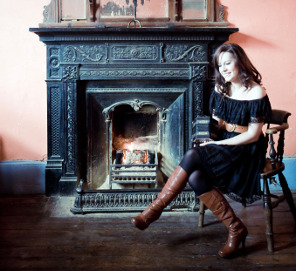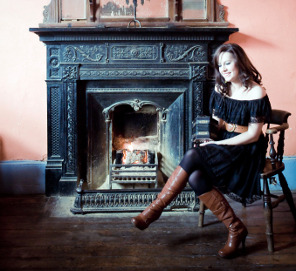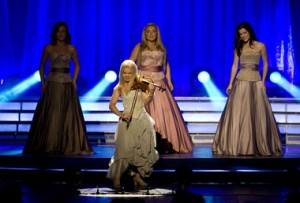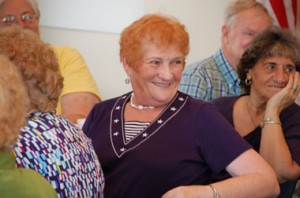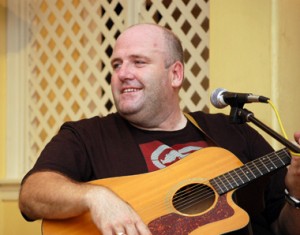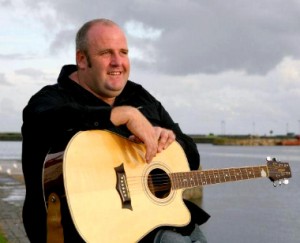To describe the concertina playing of Edel Fox is really to describe the woman herself: joyful, masterful, brilliant, engaging and effortlessly seductive.
At 24, her accomplishments and accolades are beyond the pale…and completely justified. The release of her first solo CD, “Chords & Beryls” coincides with her sixth summer spent touring the States, an annual tradition since she began playing and teaching at The Catskills Irish Arts Week. This year, Fox and Connemara fiddlers Liz and Yvonne Kane embarked on a collaborative concert tour that found them in Philadelphia last week for a Philadelphia Ceili Group performance.
“The name of the CD came from my grandmother and my aunt, who represent an older generation of the music,” Fox explained. “A beryl is a variation in the melody, a twist in the tune. “The Reel with the Beryl” is a tune by Mrs. Crotty–she was a very prominent exponent of the concertina. Herself and Aggie White and Mrs. Harrington all helped to put women on the map in terms of trad music in the 1950s and 60s. They were among the first to play in public. It really was a starting point for Irish women in music, allowing them to gain prominence on an instrument.”
By the age of seven, Fox was already gaining prominence on her concertina in her hometown of Miltown Malbay, County Clare, where her teachers included Noel Hill, Dymphna O’Sullivan, Tim Collins and Tony O’Connell. In 2004, Fox was named the TG4 Young Musician of the Year, and in 2006 she and fiddle player Ronan O’Flaherty recorded a CD together, aptly titled “Edel Fox & Ronan O’Flaherty.”
“We got so much enjoyment from doing that CD,” Fox said. “We were both very naïve to the whole process, but we loved being able to create something that people enjoyed.”
“I never felt ready to go into the studio to record my own CD, it really felt quite daunting. But last summer in the car ride up from Elkins, West Virginia to The Catskills, I was traveling with Liz and Yvonne, and they said, ‘You should do a solo album and have it ready for next summer so we can tour.’”
“Around Christmas I got on the ball,” Fox laughed. “I recorded in a studio in Miltown Malbay from January to April. I just needed a little push. I’m slow to do something, but once I put my head down it comes easy enough. I just need a little encouragement, that’s all.”
“I’d been learning a lot of tunes, some of them came from Bobby Casey, and there’s a few newer tunes as well. It’s quite a mix of stuff.”
Quite a lovely mix of stuff, and quite a lovely mix of musicians as well. Joining Edel on her cd are Jack Talty, Padraic O’Reilly, Mick Connelly, Brian Mooney, Johnny Ringo McDonagh and Una McLaughlin.
[And because I’m the writer, and I get to have favorites, this is where I mention that “The Joyous Waltz” which Edel plays with Jackie Daly on her album, is the track most listened to on my copy of the CD. It’s absolutely gorgeous. I’m also partial to the reels “The Honeymoon/Lough Mountain/Love at the Endngs.” But the tune that wins best title award is definitely “Kitty Got a Clinking Coming From the Fair.” On her CD notes, Edel writes that she has yet to find out what a “clinking” is.]
“It was a funny time of year. I’d been working for two years on getting my Masters degree in music therapy, and my final semester was this past January to May. But that’s a typical me thing to do, I work better under pressure instead of spreading it out,” Fox explained.
“I’m qualified to practice the psychotherapy and psychology of music. I really love it, using music to help people with social and emotional difficulties. My work experiences include counseling adults in a psychiatric unit and adolescents in a care home. Every client, every patient, has different needs…but they have problems expressing emotions or communicating verbally. Music can help with that, whether through listening, songwriting, instrument-playing. Sometimes it’s through improvisation—musical or percussive. It’s about bringing two people in one place together to create communication.”
In addition to her studies and album recording, this past spring Fox also continued the teaching that she’s been doing since she herself was 16.
“I teach concertina five evenings a week, from 4 or 5 until 9 at night. It’s so different from the work I do as a therapist. Teaching is about how to do ornamentation, it’s directive while the therapy is collaborative. It’s challenging, but I absolutely love it.”
“I started teaching at The Catskills my first summer there. My first time coming to The States was when I was 17, with the Comhaltas tour. I met so many people out of that, and got asked back to do gigs, and to do The Irish Arts Week the next year. It’s been great.”
Playing the 1896 Jeffries concertina that she bought from a dealer in England eight years ago (“I love the tone of an older instrument, nothing is better than the tone of a mature concertina”), Fox will soon return to Ireland to begin her Irish tour with The Kane Sisters, promoting their CDs at home. With September and the start of the teaching year right around the corner, Edel is poised to return to the busy schedule she knows and thrives on.
“I’ll be job hunting,” Fox laughed. “But I’ll have plenty to keep me busy. I love it.”

